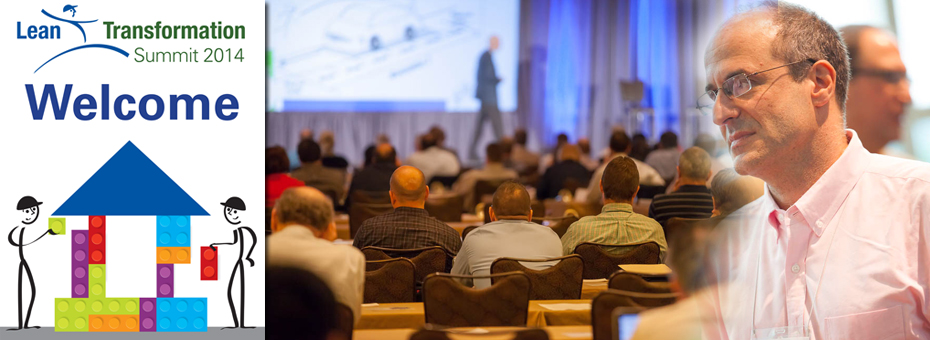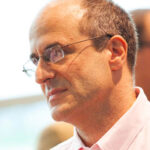The World is Too Much With Us (6PM)
Just a few last thoughts upon departing from this excellent summit.
The Food Bank of New York City story was an inspiring tale of lean helping make the world better. Presentations by Cardinal Health and GE and Ingersoll Rand proved that years of lean practice by thousands of employees at all levels continues to deliver massive benefits on all spheres. Workshop leaders shared shrewd ways to taking lean to new places.
And as the cab drove me away from the crowd, I realized that the most inspiring thing of all from this conference was the audience itself. This is my fourth summit, and I’ve come to know familiar faces. And what most attendees treasure is the opportunity to share stories, offer advice to their peers in other companies, commiserate and prop up. This year’s Open Space generated thousands of ideas shared by lean doers helping each other out. So…a toast to all those doing the hard daily work of improving their work, developing their people.
And a wry note that spending all this time among lean zealots with tales of success makes re-entering this oh-so-not-lean “real” world all the more jarring. Getting to the airport involved worlds of waste. Then there was the muda of, well, air travel. And to top it off, at the terminal I asked for a milk shake at the Cold Stone Creamery ice cream store. The lone guy there gave me a friendly smile when I ordered it; and then asked me to wait a minute. He then left the store (leaving it open and unmanned) and walked 100 feet through the airport food court to get a blender to mix it in. Yup. When he returned I asked him why. Why not keep the blender right there since he makes shakes all the time? Just because, he replied. That’s the rules for this store. Every single time he makes a shake he leaves the store to get the blender. Every time he makes one he walks it back.
So there’s that. But hey, lean thinkers. This is good news, right? We have soooo much room for improvement!
Systems Thinkers, Acting and Thinking (3:30PM)
Lex here again…
At the end of this year’s transformation summit, LEI’s John Shook pulled up a slide of the Toyota house, a visual model of Toyota’s Production System, the basis of lean thinking and practice.
As a house with a foundation and two pillars, he explained that Lean is and must be understood as a system. Indeed, most systems thinkers have some level of appreciation for Lean… And most (many?) lean thinkers, consider themselves part of the systems thinking community. Being a good systems thinker requires mindfulness, requires thinking. Shook rightly says the T in TPS should probably stand for “thinking” because Lean is about stopping and thinking when a problem comes up (whether it’s on the line or at any point in a work process, whatever the work may be).
Thinking thinking thinking is the word that comes up though, again and again. Which is why I’m grateful that Shook reminds us again and again, “It’s easier to act our way to a new way of thinking than think our way to a new way of acting.”
This is perhaps one of the most difficult aspects/paradoxes of Lean. We have to wrap our heads around lean concepts and tools first (or do we?), so we come together and think and talk together at conferences like this one, but the thing that REALLY makes the difference is going back and making Lean our own by changing our daily actions.
At LEI, we work hard to encourage lean thinkers both to act and think. The trap of course is when we stop there, when we come together and get super excited about ideas, then go back to our organizations or our daily routines and fail to apply lean thinking to our real work; apply PDCA thinking; identify, communicate, and tackle problems with our team members; run experiments and just try something.
Ok, ok, enough thinking, right? It’s been a great couple of days, full of learning and interesting ideas. I’m going to do something a little bit different and intentionally take just one idea back with me to my writing and editing work: expertise flow.
This idea is from Durward Sobek who spoke yesterday and today about managing expertise flow (among other things) in his talk on Lean Product and Process Development. Sobek reminded us there’s always the flow of the work, yes, but as we learn something new with each project, there’s expertise flow as well… This is and isn’t the same thing as what we call “knowledge work.” And expertise flow needs to be understood, captured, and managed well, too. This sounds simple. It isn’t. So often we do our work, learn something about how we do our work, have an “a-ha” moment, and then lose that idea, start again from point A the next time we go back to our work.
This idea of expertise flow excites me because if we want to share knowledge effectively, whatever our field, we better figure out how to “catch it” well when it gets created, in our organizations and in the world. I plan to go think about this, then stop thinking and run some super simple experiments. What did you learn at this year’s Summit? What questions did Summit sessions spark in you?
Happy Summit 2014, friends! Don’t forget to share your learning by submitting an article to The Lean Post!
Respect for (All Kinds of) Resources, Respect for People (11:45AM)
Lex Schroeder here with more thoughts on Food Bank For New York City…
Margarette Purvis spoke this morning and now I’m learning more about the organization at the breakout session with Purvis, Jamie Bonini of TSSC, and other Food Bank leaders.
Here’s what I love about Food Bank. They make lean thinking and practice their own. They use Lean to deliver most effectively their own mission, to meet their need—not just to learn Lean because it’s supposed to be a good thing.
Food Bank doesn’t just deliver food to New Yorkers in need of assistance; they think strategically and systemically about the myriad challenges their clients face every day and work to solve problems from there, with that larger context in mind. People need food, yes, but also financial counseling, tax assistance, and access to opportunity. People are struggling and their time is as valuable just like everybody else’s. It isn’t just about giving people food, it’s about getting people help in a way that respects and maintains dignity. It’s a hard thing to ask for help, Purvis reminds us—“shame is very real and it prevents people from getting the help they need.” So when Food Bank works with Toyota to improve lines, it’s not about moving people through a line faster to move people through a line faster. It’s about getting people help faster because people shouldn’t have to wait an hour outside in the cold in the middle of winter or the high heat of summer for a meal.
I had the privilege of visiting Food Bank last month and visited the soup kitchen in Harlem. I saw the need for food and services. I saw the warm, welcoming experience Food Bank creates for clients. Most of us know millions of people are living in poverty, but seeing it is a different thing. Seeing it makes it real and makes you want to make things better, any way you can. This is when lean process design gets exciting for me. One of the biggest misconceptions about Lean is that it’s all about efficiency. Sure, Lean is “efficient,” but it also demonstrates respect for resources (time, money, energy, food, materials/supplies). This respect for resources connects to everything.
During one of the talks yesterday, a speaker said Lean was ultimately a growth strategy. For some it is, for others it’s not about this at all. Food Bank doesn’t want more customers/clients! In this case, it’s about how to work effectively with very limited resources. This organization needs donations, relies on generous donations, but this doesn’t mean it can’t work most effectively with its current resources. In nonprofit and philanthropic circles, there’s a lot of talk about organizations that put a much-needed band-aid on social problems (to “stop the bleeding”) and organizations that work hard to address systemic inequities and make systemic change. Food Bank does BOTH of these things… And Lean, this simple/not so simple process design thing helps Food Bank do both: get people food and improve processes so that Food Bank staff are freed up to address larger, longterm, systemic problems like hunger and poverty. That’s an incredible thing, a hope-full and inspiring thing.
Best Lean Story Ever? (11AM)
“Our work is about love” shared President/CEO Margarette Purvis of Food Bank for New York City. And she spoke this morning about how TPS fundamentally supports this non-profit agency delivering food (more than 1.5 million people served last year) and related services.
In the most inspiring lean talk I’ve seen ever, Margarette powerfully tied the spirit of lean/kaizen to the mission of Food Bank. For her a light bulb went on in her lean learning when she discovered the work of the Toyoda family making improvements to the textile business—work that was prompted by the Toyoda mom, she said. “What we connected to was that there was a goal of improvement that was connected to love,” she said, “And that was food bank all day. Our work is about love.”
Love of course is what we might call, in lean language, “situational.” In this case, Food Bank wraps up its love in hot meals and warm shelter and other services that deliver on their mission. Yet love is a word that crops up constantly when Margarette explains the lean juice nourishing their organization.
“For us efficiency is key,” she explained. The Food Bank faces daunting challenges. As a non-profit its finances are constrained. Operating in New York presents thousands of logistical challenges. And of course learning to deliver the right services to its customers is complicated. “Our business is one with a lot of diversity, a lot of problems…which is why it is so perfect for kaizen,” she said.
For example, one clear goal that has emerged was simply “attacking the lines,” according to Margarette. Food Bank customers don’t want to wait in outdoor lines. One obvious reason is that for many, coming into the food pantry is the one time they will be in a warm place for the day. So cutting that outdoor time is vital.
And, as Margarette shared, “When you are standing in a line…people see you in the line. And being on that line can lose some dignity for you.” And that’s why getting people off of that line is incredibly important to the mission. Because, as she noted, “Poverty robs you of so much, it should not rob you of your dignity.”
Food Bank partnered with Toyota Production System Support Center (TSSC) and embarked on a lean journey that continues today. To jump forward, through intensive kaizen work, they realized dramatic results—a reduction in line waiting so significant that people started asking her “did you go out of business?”
Let’s be honest: this is the kind of story that most of us WANT to like. But it’s a not a great story because it’s a story about being Good. It’s a great story because there’s so much learning to share. Margarette and her team have so much to share about how to deploy kaizen effectively in a far-flung resource-poor organization with myriad complicated human and logistical challenges.
TPS/lean represented the best form of support for Food Bank. That’s because most other well-intentioned efforts were not aligned properly. As Margarette shared, when people would say the word “just” as in “why don’t you ‘just’ do that?”, most charities only hear that as an insult—someone telling them how they SHOULD be doing it. And then came kaizen.
“Kaizen is really a system to help you find the best system that works for you” she said. “This is the foundation for respect which is the best tool for collaboration.” TSSC worked to help Food Bank adopt the principles and align them with its mission.
Key to gaining traction was the “matchmaker” principle, says Margarette. Communication and posturing are vital, but they must be done properly—and in a focused way. “You can love lean all day,” she says, “But you have to make sure that the right people fall in love with it. You have to be strategic about who falls in love.”
Getting traction for the lean work required a shrewd understanding of the personalities of the people doing the work itself. Margarette found that simply sharing abstract talks about this Japanese term was less effective than tapping into the natural competitiveness of some of her workers. Simply telling them about the results that some of their competitors were enjoying was motivation for them to do the work.
Of course, there were initial challenges making it work. “At first we did a good job of teaching kaizen, but we didn’t do a good job of connecting kaizen.” Doing kaizen with a silo approach was ineffective, for example. “You have to address the silos before you can deal with lean.”
Over time they learned how to own the approach. And the key was “Never standardizing the step by step but standardizing the goal.” Given the operations of this particular organization (lean is situational), optimizing each line was a matter of becoming clear and aligned about mission. “The very first standard was about clearly defining the goal. We have learned that this is the seed that the system planted. Our goal is to move people quicker,” says Margarette. And having the goal established “gives people permission to make changes that make it happen more effectively.”
Finally, Margarette shared this gem: “If you love kaizen, love it the right way. Love it with respect.”
She said that Food Bank’s lean work is comprehensive and requires respect for people that goes beyond being polite; its about enabling people to make improvements. She shared how the most effective teachers at Food Bank are not those who have simply drunk the lean Kool-Aid. They are the ones who “transfer enthusiasm.”
And she shared that passing on these skills sometimes has unintended consequences: “If you are going to give people the skill sets of kaizen, you better give a bunch of people that skill set…because you never know when they are going to be walking out the door.”
To wrap up for now, the genius of her talk was her ability to link lean with love…at the gemba. Rock on, Margarette and crew. Here’s a line of yours that should resonate with many:
“Nobody wants a love that is not respectful.”
GE’s Great Story (10AM)
Greetings from day two. Terrific morning jolt delivered in 45 minute presentation from Kevin Nolan, VP Technology of GE Appliances. Shared story of the transformation and revitalization of this $5.6 billion division. For now, here are just a handful of key quotes:
“As engineers we love data as long as its not about our own ideas.”
On the profound change that this division went through regarding its approach to the operators: “The operator is really the most important person in the business…and that mindset does not come naturally and once you have that mindset understood by the whole organization the mindset changes. Once you have that kind of respect and understanding…you look at how much knowledge they have. Once you start seeing a little bit it catches on. It is your best resource and it is the most under-utilized.”
“The operators had a ton of complaints. But they had a ton of solutions too.”
“All you have to do is not listen to operators one or two times and they will turn off.”
“One of the hardest things about lean: you see it, you think you get it, but it takes years of practice.”
“From a lean sense, the biggest waste is when we launch a product and it doesn’t sell.”
“Throughout my career, the more innovative products we develop tend to fal the most.”
“You don’t want engineers trying to be artists.”
More later, gotta tune in to the next great speaker.







